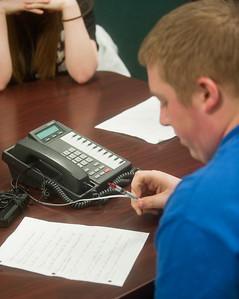
Brian Wrightsman, a North Central High School science teacher conducting research off of Costa Rica, spoke Monday morning to current and former students from a submersible on the seafloor.

Brian Wrightsman, a North Central High School science teacher conducting research off of Costa Rica, spoke Monday morning to current and former students from a submersible on the seafloor.
"Hello. This is Brian Wrightsman calling from the bottom of the seafloor near Costa Rica," sounded the tinny, far-away voice through the speaker phone to smiles of delight around the conference table at North Central High School.
Then the questions began.
Wrightsman, a North Central High School science teacher conducting research off of Costa Rica, spoke Monday morning to current and former students from a submersible on the seafloor.
"Brian had a good breakfast, he's in natural clothing and in stocking feet, he couldn't wear shoes," said Tony Rathburn, ISU associate professor of geology, speaking to the students via telephone aboard the RV Atlantis before they were connected to Wrightsman. "I'm sure it's starting to get chilly there."
Wrightsman, a 2007 Indiana State graduate, is accompanying Rathburn on a National Science Foundation-funded expedition that takes scientists into the depths of the ocean to explore methane seeps by using the Alvin, a manned submersible that can travel up to 4,500 meters (about 14,764 feet) below sea level.
On Monday morning, Wrightsman, the pilot of the Alvin and another scientist descended about 1,000 meters and began exploring and sampling the seafloor. Then at 11 a.m. (EST), five of Wrightsman's former and current students were allowed to ask him questions about his experience, life found on the seafloor and the organisms he is studying.
"Right now, we're working on a transact looking for spots to take samples of," Wrightsman informed the students. "We're seeing a lot of creatures down here, it's hard to describe. Some are creatures never seen before. We'll take a lot of sediment samples, take a lot of pictures and spend a lot of time sitting in a big bubble."
One creature Wrightsman described was the yeti crab, which has long claws that look like oversized, very hairy arms. "It's a crazy-looking beast," he said.
Samples collected during Alvin's first dive on Sunday netted a possible new species of worm, which was attached to coral, Wrightsman said.
"By no means are we done discovering new things," he said. "We're nowhere near done."
The Alvin is scheduled to take 14 dives during the two and a half week cruise.
When the crew descends in the Alvin, they spend eight hours exploring the sea floor before ascending to the surface. In answer to questions about how they retrieve samples on the seafloor, Wrightsman explained the Alvin has "two great big robot arms -- it's like off of a space movie -- and they reach out and grab samples." Those samples are then placed in baskets outside of the Alvin and brought to the surface for the scientists to examine.
To one student's question, Wrightsman said there are no signs of habitat degradation; in fact he said it was the opposite.
"It's teeming with life," he said. "It's all growth and prosperity on the seafloor."
Part of the scientists' research is into organisms that feed off of the methane.
"The organisms that live in the rocks are the ones building the rock," Wrightsman explained.
Further study of the organisms on the seafloor could have positive ramifications on land.
"They're taking methane and turning it into a solid. If we see how they are doing that, then perhaps we can as well," he said. "That could reduce greenhouse effects."
Students gathered for the telephone exchange described it as "really cool" after Wrightsman signed off with, "I miss you, Indiana, but I'm having a really good time. I hope we get a lot of good stuff."
"We're not just talking to him, we're talking to our teacher," said Brooke Johnson, a sophomore at North Central.
Frank Grissom, a junior who is taking Wrightsman's earth and space science class, said he has a lot of questions for his teacher when he returns.
"It's really cool that one of our teachers gets to actually do this and come back and teach us," he said.
Christine Brunger, a junior in the same science class as Grissom, said hearing about her teacher's experiences makes her more interested in science.
"It's really neat to learn about things at the bottom of the ocean," she said. "You see different things than on land."
To follow Wrightsman's adventure, visit his blog at: http://blogs.indstate.edu/~wpmu/brian/
-30-
Writer: Jennifer Sicking, Indiana State University, assistant director of media relations, at 812-237-7972 or jsicking@indstate.edu
Photo: http://isuphoto.smugmug.com/photos/479372112_nGThy-D.jpg
Cutline: Frank Grissom, a junior at North Central High School, asks his teacher Brian Wrightsman a question. Wrightsman, who was in a submersible on the sea floor off of Costa Rica, took a month leave of absence to participate in a research cruise with Indiana State University. ISU Photo/Tony Campbell
Photo: http://isuphoto.smugmug.com/photos/479371652_JX8qr-D.jpg
Cutline: Frank Grissom, a junior at North Central High School, asks his teacher Brian Wrightsman a question while Brooke Johnson, a sophomore, listens. Wrightsman, who was in a submersible on the sea floor off of Costa Rica, took a month leave of absence to participate in a research cruise with Indiana State University. ISU Photo/Tony Campbell
Photo: http://isuphoto.smugmug.com/photos/460268463_KtJ8h-D.jpg
Cutline: Brian Wrightsman. ISU Photo/Tony Campbell